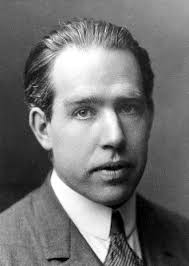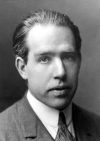Niels Bohr Contributions to Quantum Mechanics improved Rutherford’s nuclear model by suggesting that the electrons revolve in the discrete energy orbits and they do not loose energy while they are in the orbit. Once they move from one orbit to another they emit energy.

Niels Bohr 2n2 formula
Electrons are found by 2n2 formula in different shells where n=shell
So n=1 , 2 electron,
n=2, 8 electrons,
n=3, 18 electrons,
n=4, 32 electrons
He also suggested that outermost shell(orbit) cannot accommodate more than 8 electrons.
Energy of electron E= hv where h= plank’s constant and v is frequency of electron.
C=vλ where c= speed of light and λ is wavelength . Thus frequency and wavelength are inversely proportional to each other.
In 1913, Niels Bohr developed his groundbreaking atomic model and revolutionized our understanding of the physical universe. Find out more here.
Article
Niels Bohr was a Danish physicist whose groundbreaking atomic models have revolutionized our understanding of the physical universe. In 1913, he proposed his atomic model and earned the 1922 Nobel Prize in Physics for his work in developing quantum theory.
Introduction to Niels Bohr’s Contributions in chemistry
Niels Bohr was a Danish physicist who made very important contributions to the understanding of quantum mechanics. In 1913, he proposed his revolutionary atomic model which helped shape our current understanding of chemistry, physics, and even biology. He developed a deep understanding of how electrons behave in atoms and made the foundational theories that are still used today.
Theory of Atomic Structure and Spectra.
Bohr’s most groundbreaking and noteworthy contribution was a theory of atomic structure, an idea which he put forth in 1913. This theory led to the discovery of electrons being in various concentric shells around a nucleus, rather than in just one general area. He also discovered the mathematical formula for calculating the energies of these electron shells and the frequencies at which electrons move between them. This knowledge played a vital role in our understanding of chemistry and allowed us to explain phenomena like spectral lines.
Complementarity Principle & Wave-Particle Duality Theory.
The Principle of Complementarity and Wave-Particle Duality Theory were two of the major contributions made by Niels Bohr. These theories highlight the fact that physical systems such as atoms cannot be described using solely one type of description; rather, a balance between both wave and particle descriptions must be considered. This meant that physicist had to incorporate considerations from both classical physics and quantum theory when studying physical phenomena, leading to greater progress in understanding the universe around us.
Production and Utilization of Nuclear Energy
Niels Bohr also made great contributions in the production and utilization of nuclear energy. He proposed the idea of a fusion reaction, which is when two nuclei are combined to form a larger nucleus. His work during WWII led to the development of the atomic bomb, and his research on uranium and plutonium fueled the creation of nuclear power plants. Ultimately, he helped pave way for sustainable sources of energy that can be used in many applications.
Other Contributions and Achievements in Quantum Mechanics & Physics
Beyond his work on the atomic model, Niels Bohr made other significant contributions to quantum mechanics and physics. He developed the process of Bohr radiations, which refers to the emission of electrons from atoms when exposed to external electric fields. This concept further revolutionized our understanding of the structure of matter. Additionally, he was also awarded the 1922 Nobel Prize in Physics for his groundbreaking theories about the nature of atoms.
Read about Notes on Quantum mechanical model of Atom



